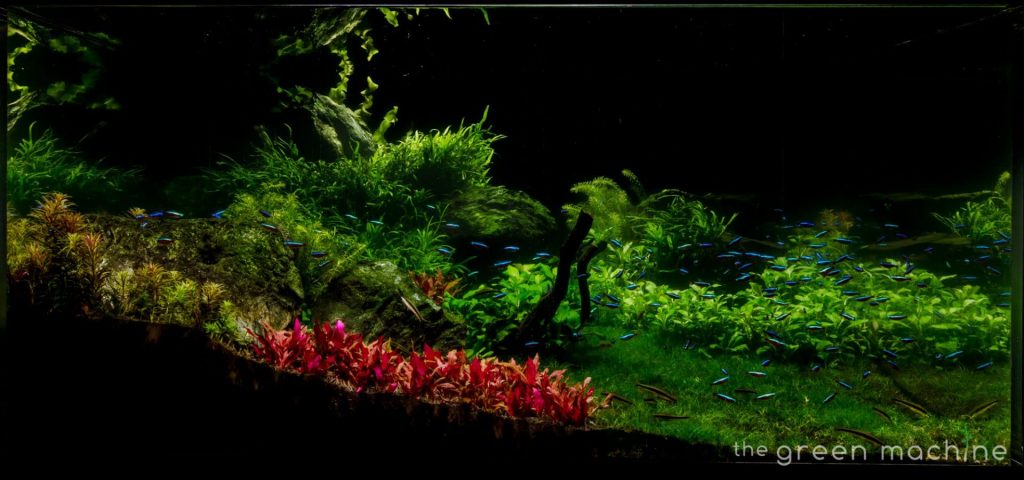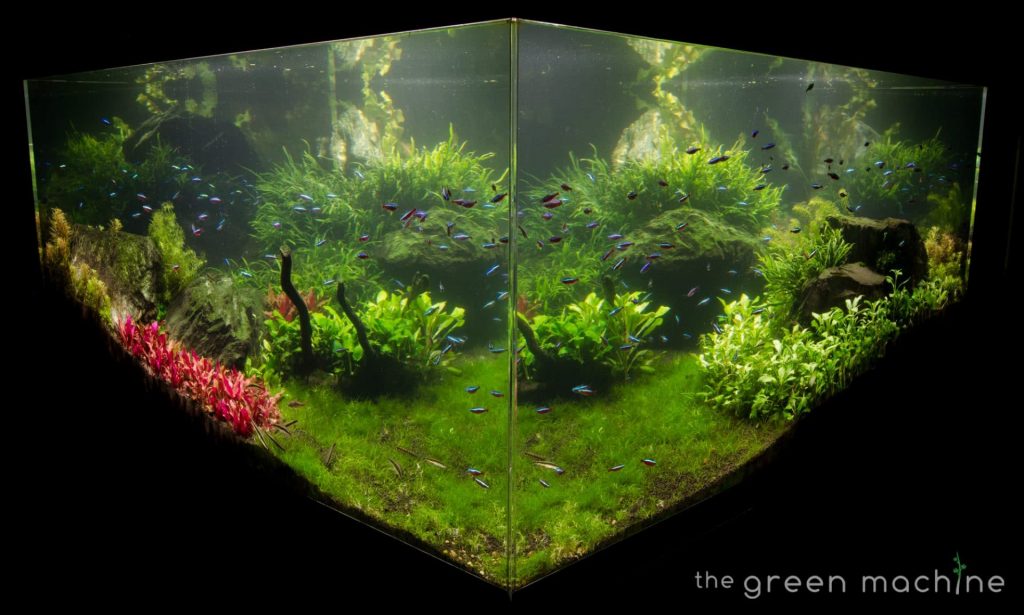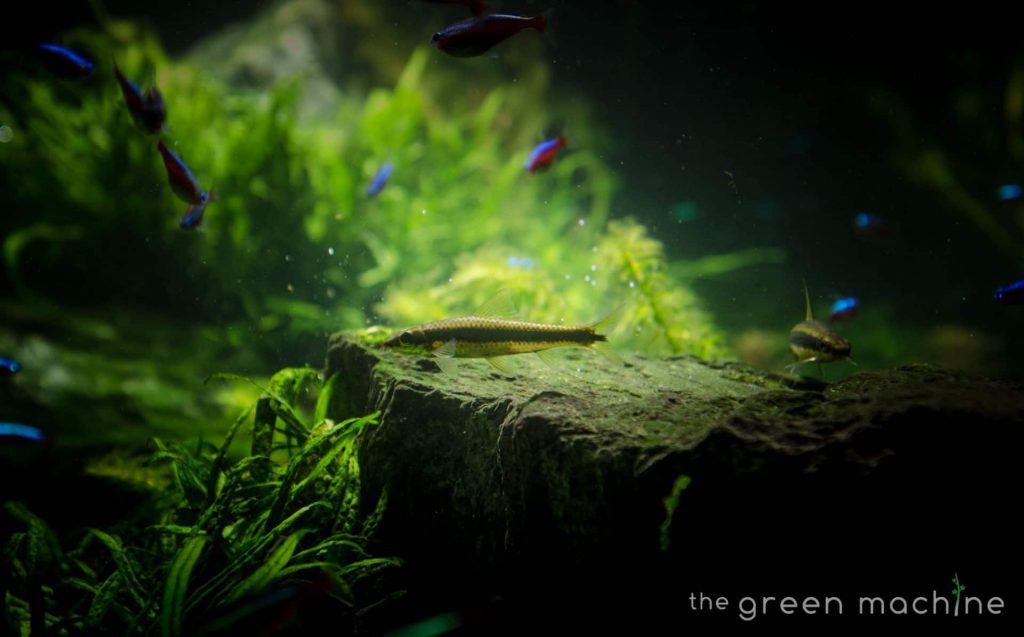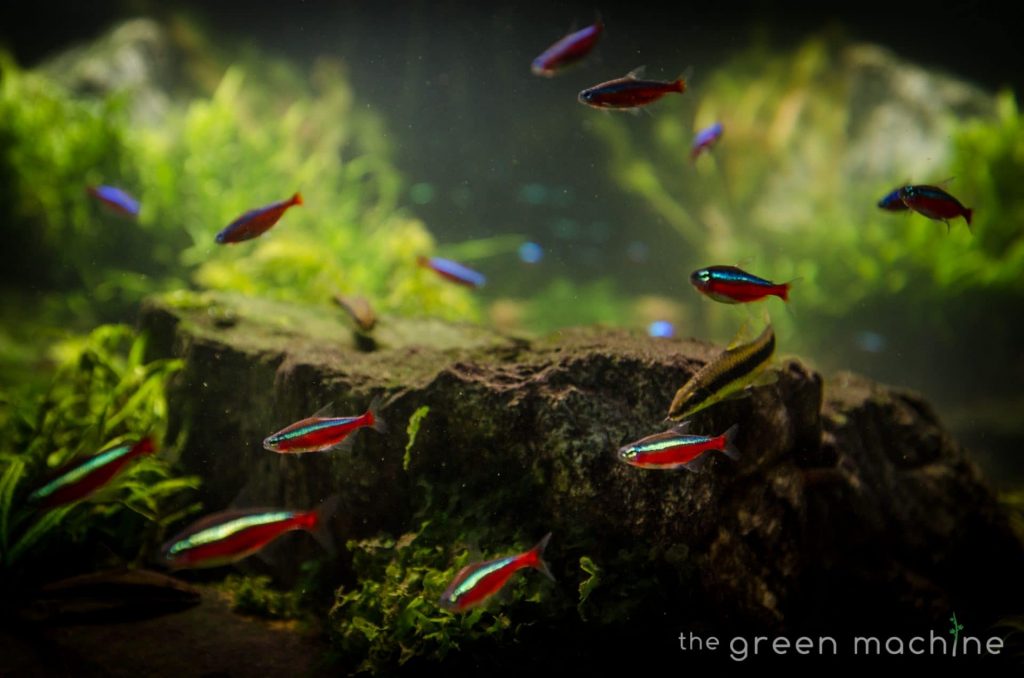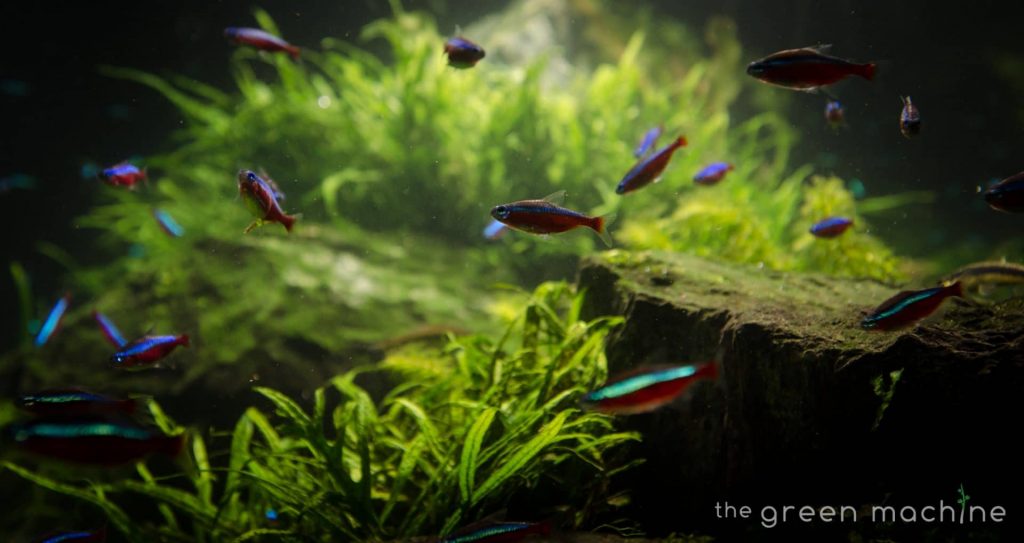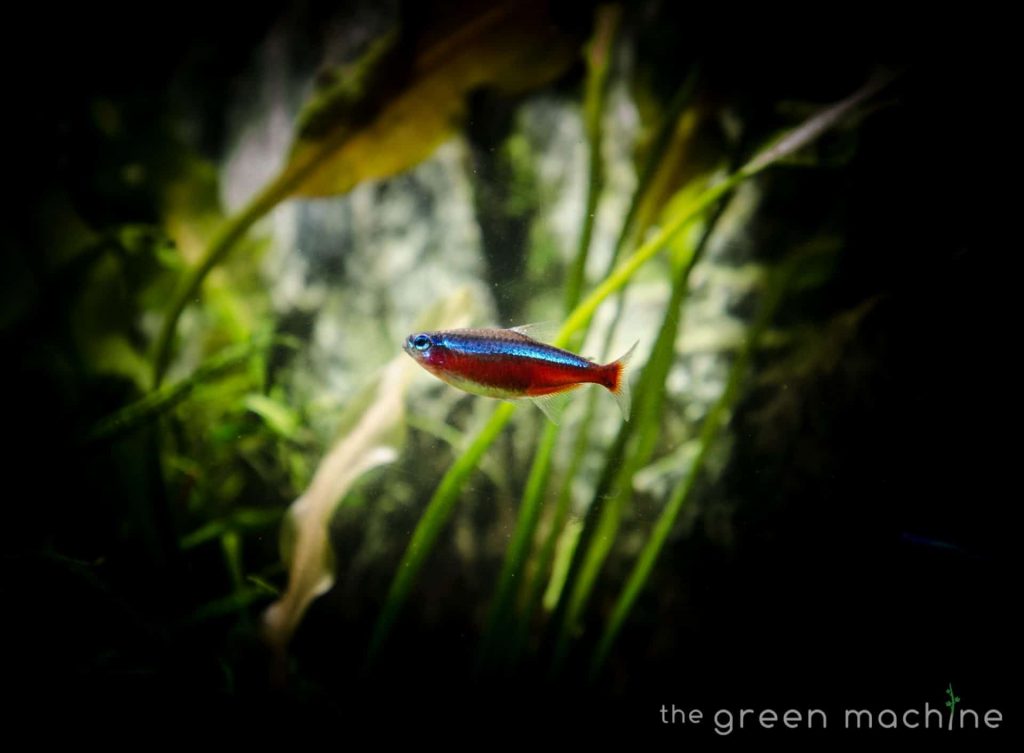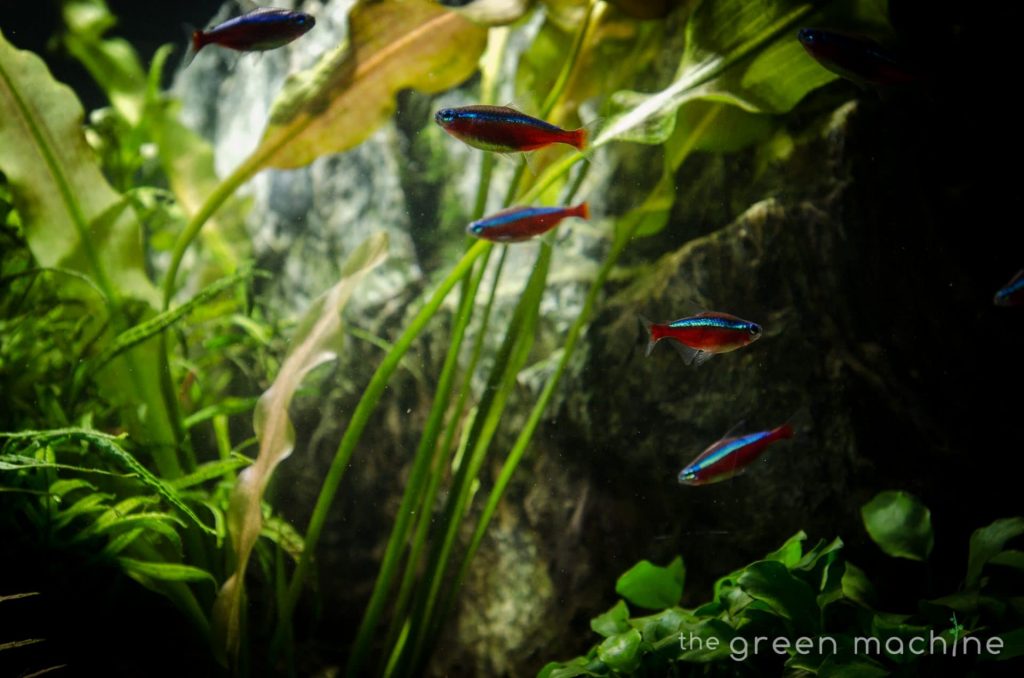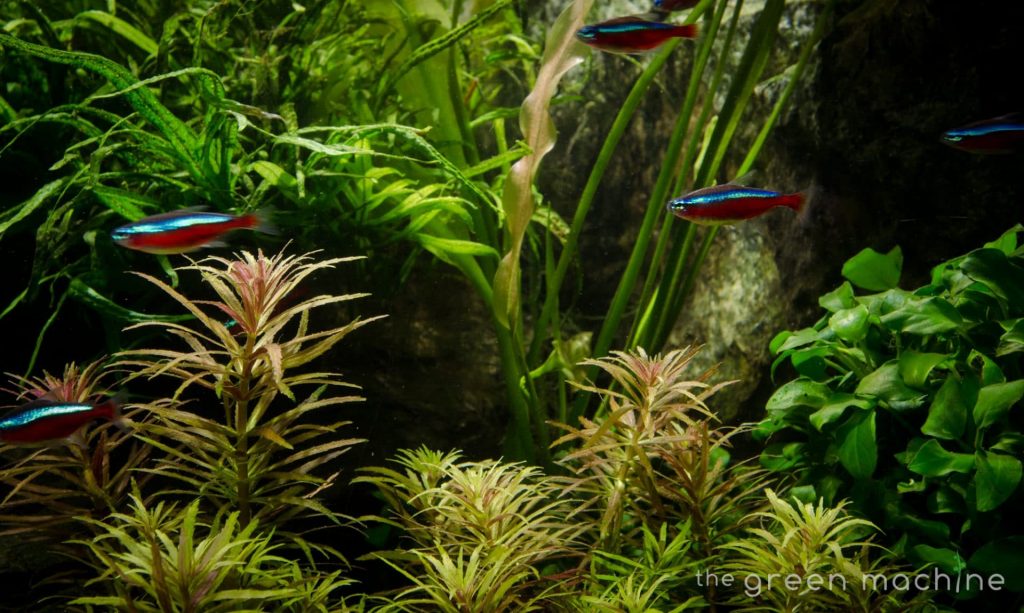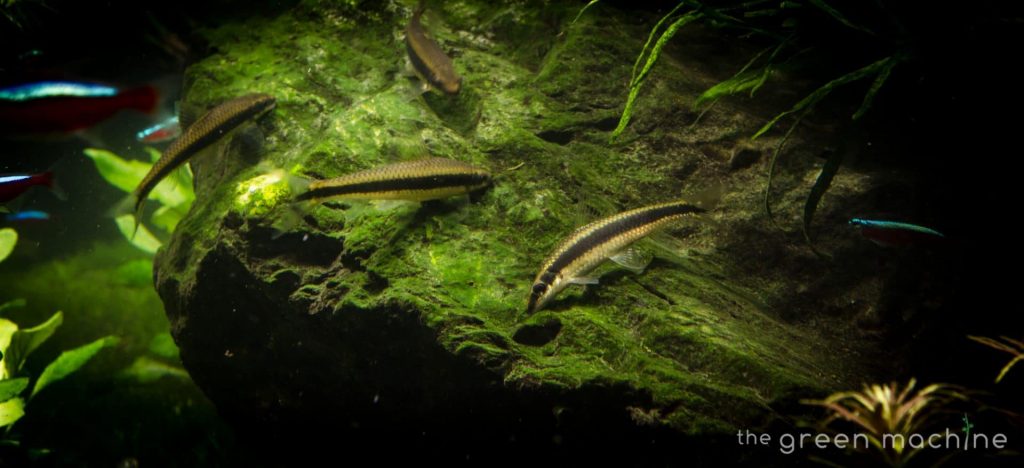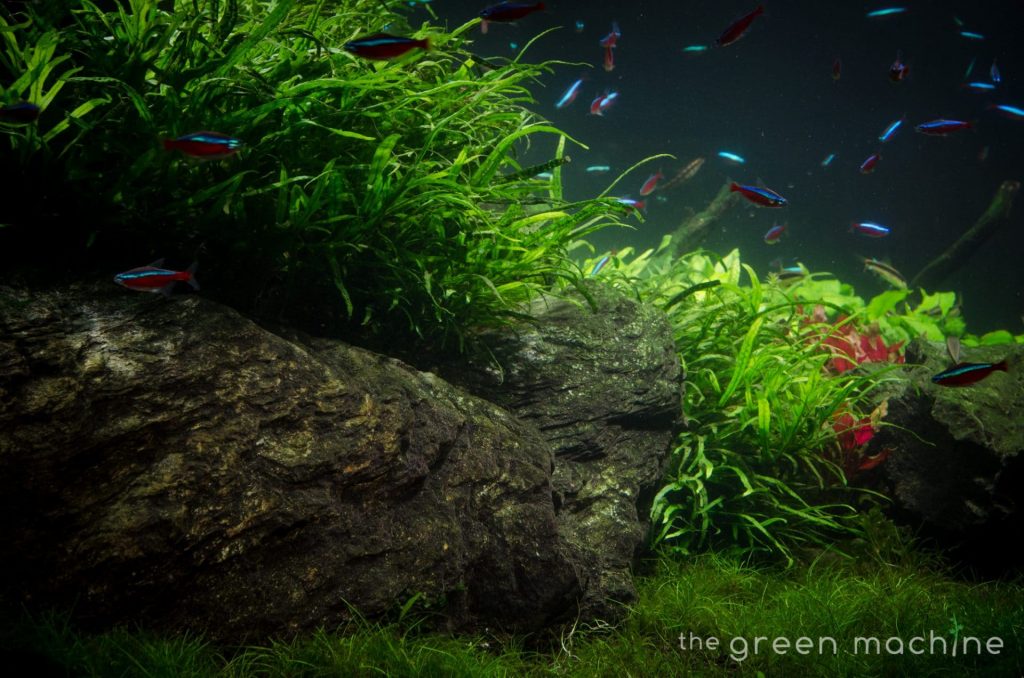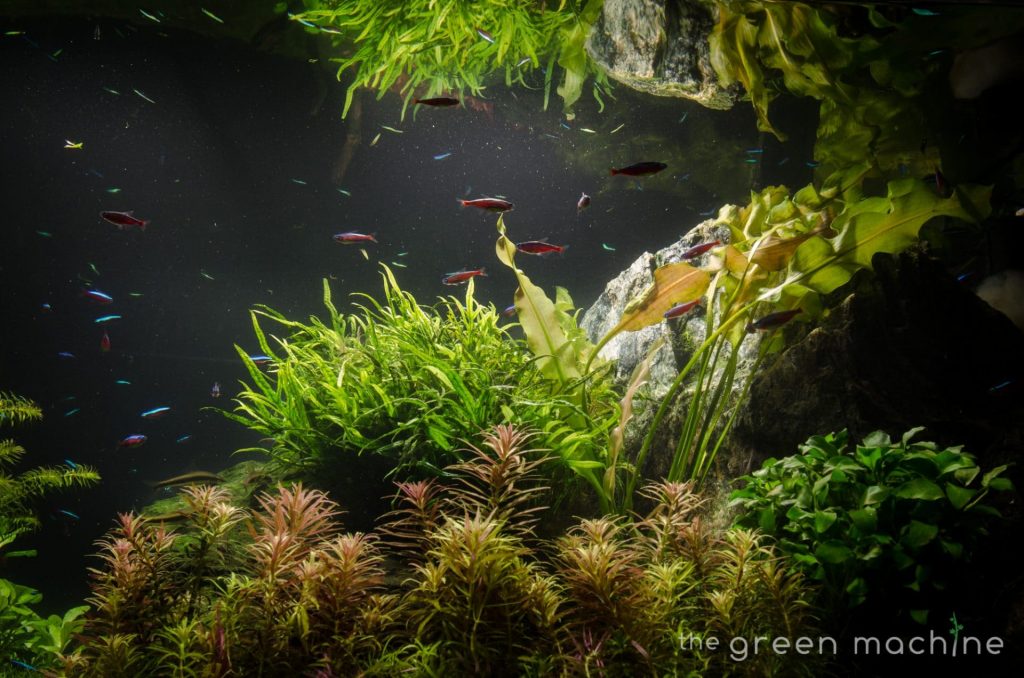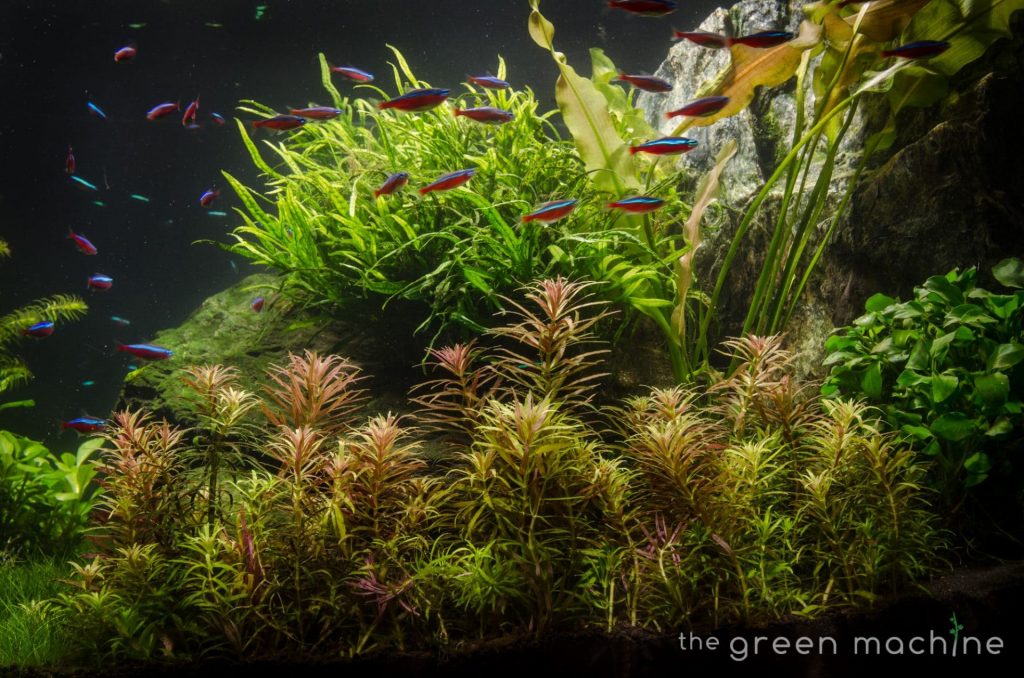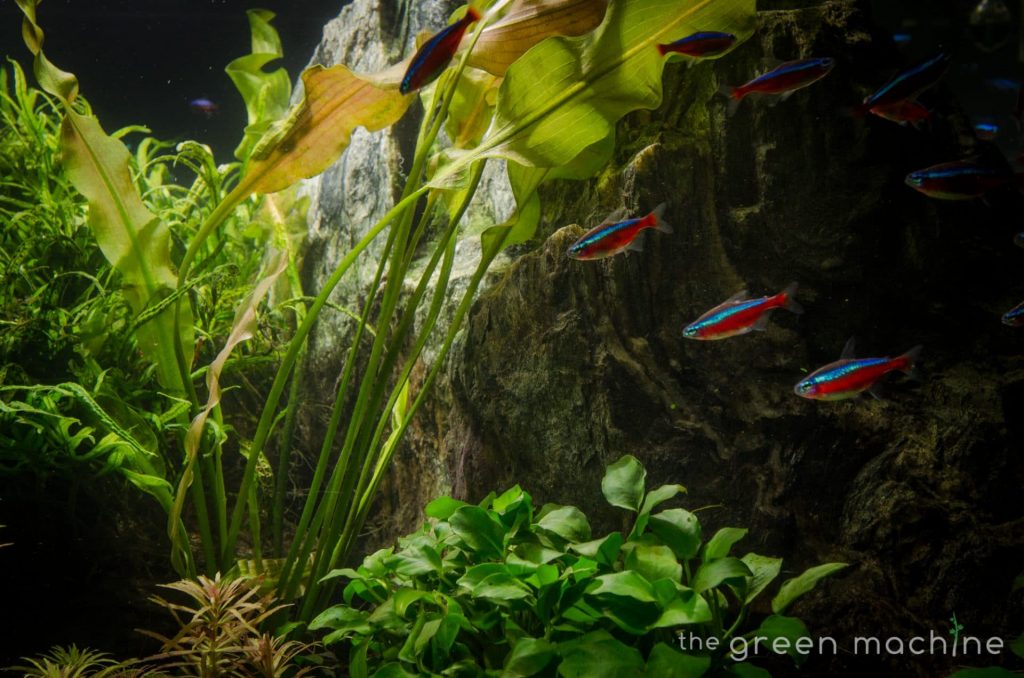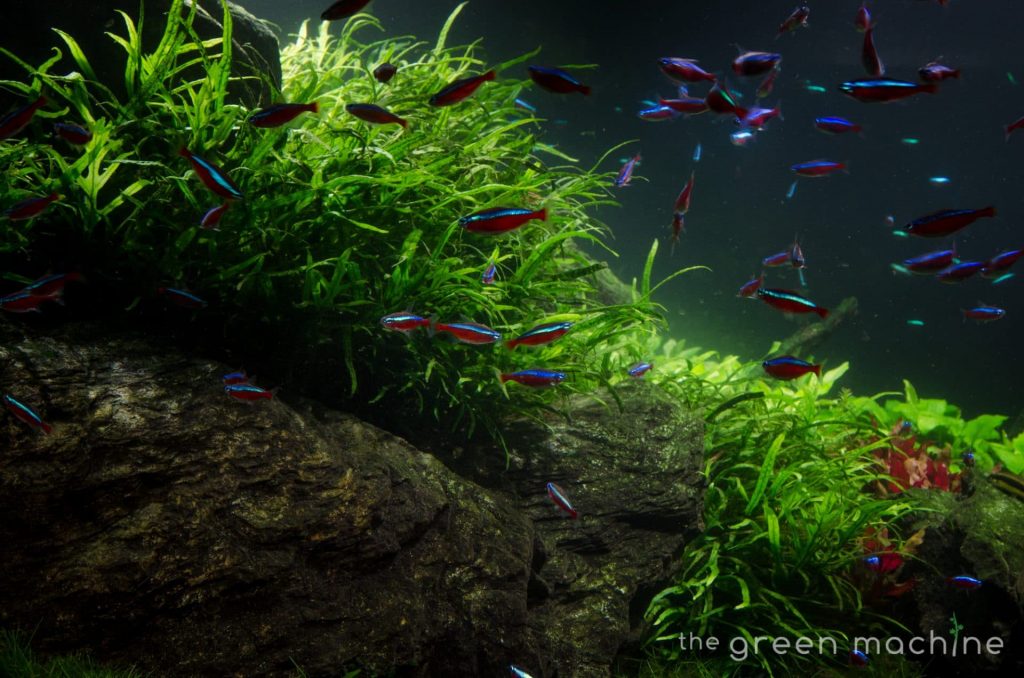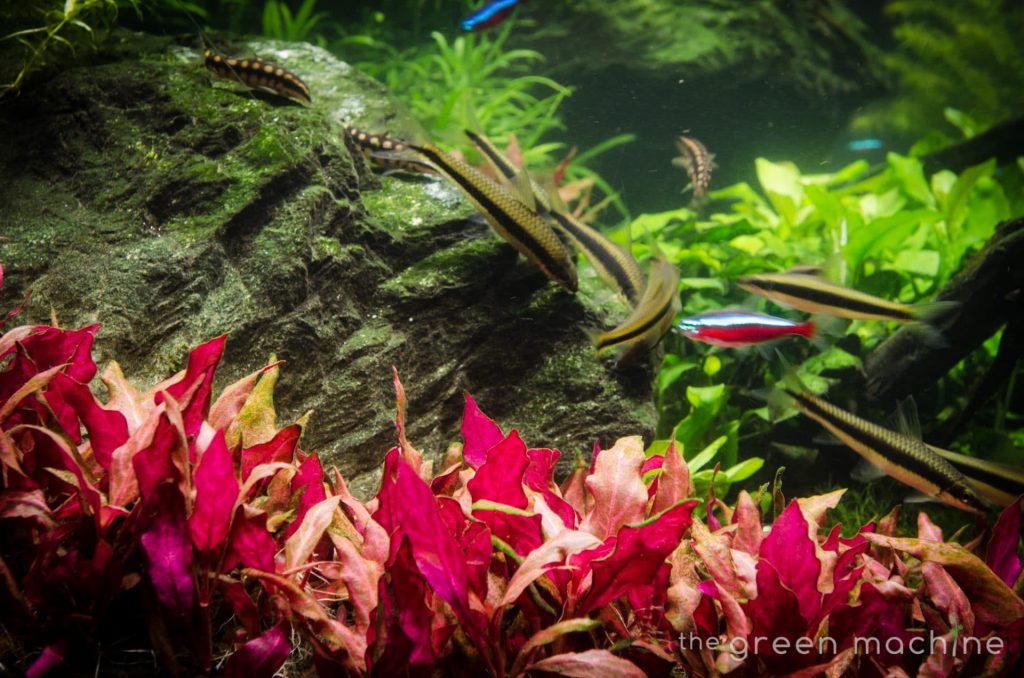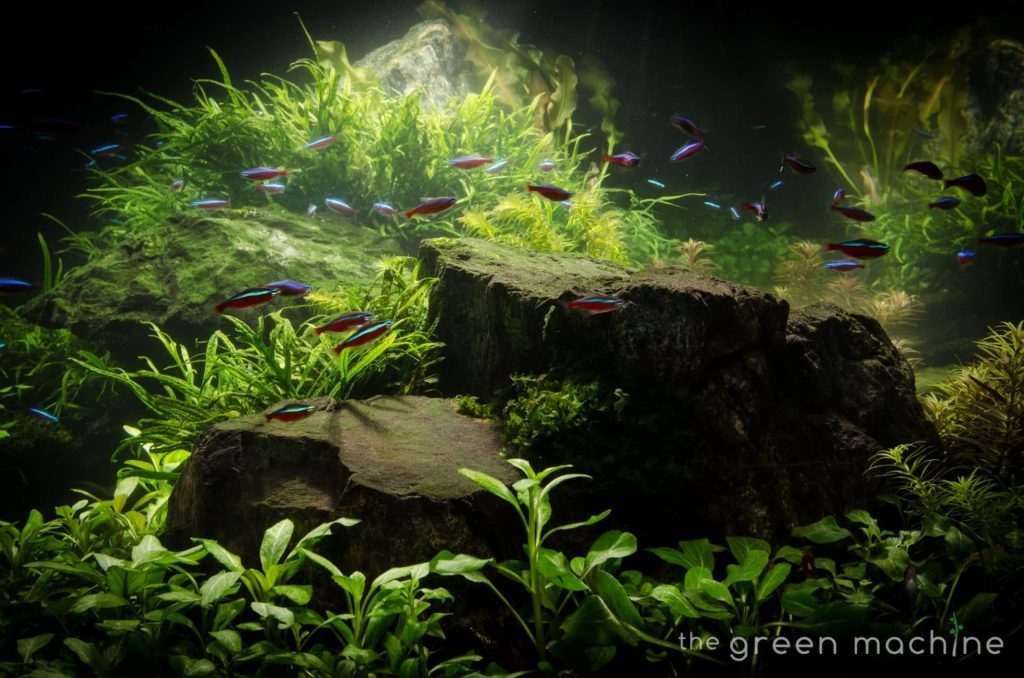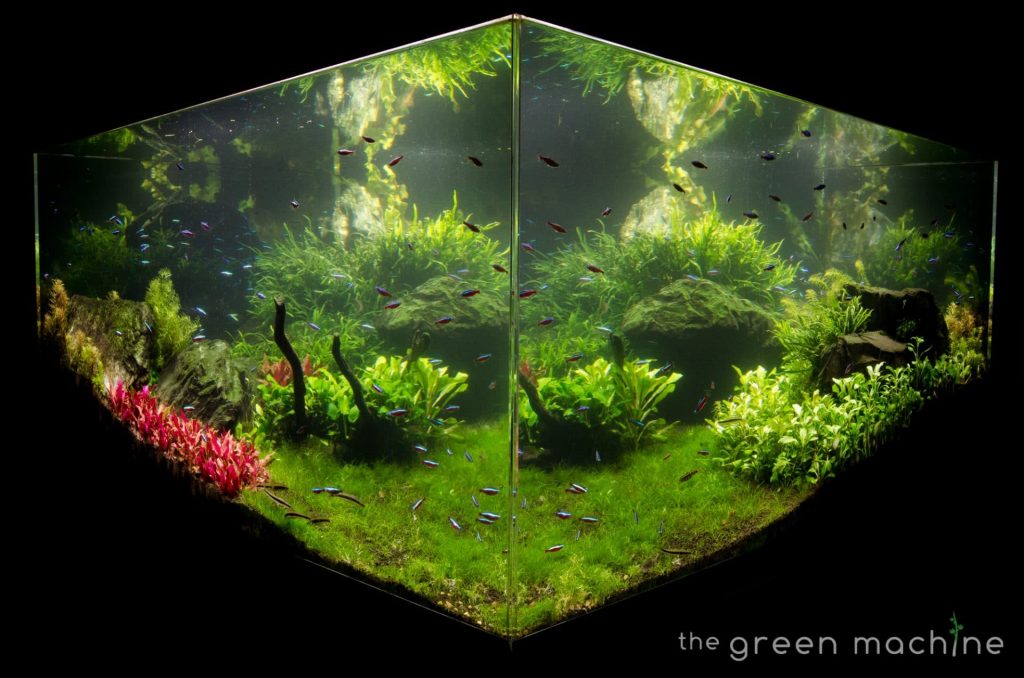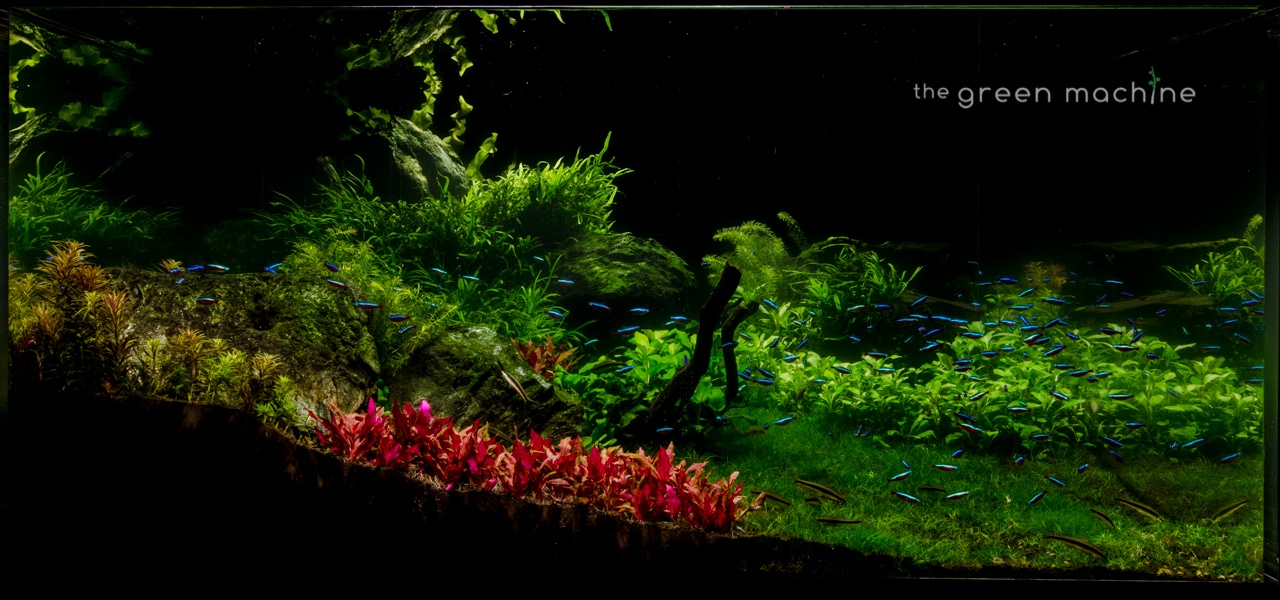
In this aquascaping tutorial we’ll guide you through each stage of the creation of a huge planted tank layout by founder of The Green Machine and professional aquascaper James Findley.
Aquascapes are fine-art tropical fish tanks where the focus is on plants and natural décor, rather than fish.
This tank is huge- the same tank used in Nature’s Chaos aquascape which you can find several videos for on our website.
Setup Specifications
AQUARIUM & CABINET
- TGM All Acrylic Aquarium 5ft x 5ft x 2.5 ft high (150cm x 150cm x 75cm high)
- TGM Custom Stand
SUBSTRATE SYSTEM
- TGM Substrate Supports
- ADA Powersand Special M
- ADA Aquasoil Amazonia
- ADA Aquasoil Amazonia Powder
- ADA Tourmaline BC
- ADA Clear Super
- ADA Bacter 100
HARDSCAPE MATERIALS
FILTRATION SYSTEM
- Eheim 2080 Filter
- ADA Bio Rio Filter Media x 3ltr
- Sera Siporax Filter Media x 7 ltr
HEATING
LIGHTING
CO2 SYSTEM
AQUASCAPING TOOLS
FINAL PLANTS USED
- Rotala rotundifolia
- Limnophila hippuroides
- Fissidens fontanus
- Rotala ‘Bonsai’
- Eleocharis sp.mini
- Aponogeton madagascariensis
- Alternanthera rosanervig
- Alternanthera reineckii mini
FISH USED
- Cardinal tetra
- Botia sidthimunki
- Various Corydoras
- Siamese flying foxes
- Amano shrimp
Find the video transcript below the image gallery.
Step by Step Photos
Video Transcript
00:00
Welcome back to The Green Machine, the Nature Aquarium specialists.
In this aquascaping tutorial we’ll guide you through each stage of the creation of a huge planted tank layout by the founder of The Green Machine and professional aquascaper James Findley.
Aquascapes are fine-art tropical fish tanks where the focus is on plants and natural décor, rather than fish.
00:21
For this tutorial we’ll start with the empty aquarium- in this case a huge 5ft x 5ft x 2.5ft acrylic tank.
The first stage is to add a base substrate layer which is made up of natural additives and nutrient rich materials such as ADA Power Sand Special. This will provide the best environment for plant growth over a long period. James focusses these materials in the areas he plans to have most plant growth.
01:44
Next he starts to build height using lava rocks which are easy to position and also offer fantastic biological filtration due to their porous structure. If everything is placed on the bottom of the aquarium with only one height or level in the design the result can feel quite flat and lacking in dynamics. So James often uses contrasting high and low areas to make his layouts more dynamic.
Often when creating aquascapes, James spends time considering hardscape and plant placement before he begins, sometimes making sketches, or keeping the design in his mind.
However on this occasion he titled this aquascape ‘Spontaneity’ because he didn’t pre-plan his design. Instead he surrounded the aquarium with pieces of hardscape and selected each piece as he went along, forming the design moment-to-moment.
There are no right or wrong methods for creating a layout design, but it can often be tricky for beginners to visualise how a grown in aquascape will look. With experience however, one learns how various aquatic plant species grow and can keep this in mind when placing hardscape.
James has had many years practice across various styles and sizes of aquascapes which makes this task fairly straight forward for him.
If you are just starting out, you may find it useful to sketch out a design beforehand. You can research how certain plants grow and decide on a hardscape and plant layout at this stage so you can begin with more confidence.
03:15
A paintbrush is a useful tool when moving and positioning substrate materials.
You can see three mounds of height forming at 3 of the corners, with one low area at the other corner. This low area will form a flat plane for carpeting plants.
James likes to add plenty of substrate additives at this stage in order to create the best possible environment for plant growth- making maintenance easier down the line.
The top layer of substrate is ADA Aqua Soil which can be used on it’s own but benefits from the extra additives and Power Sand beneath.
04:02
When placing the first stone in a huge tank of this size is can be a daunting moment! How should the aquascaper proceed from this point?
04:19
Now some huge stones are carefully positioned in the layout- these will play a big part in the overall composition.
The challenge of working with such a big aquarium can be seen here- the person physically positioning the stone is so close that it is hard for them to see how it affects the layout- so James directs from outside the tank.
With smaller aquariums it is easier as the aquascaper can position a stone and then take a step back to observe the results, repeating until he or she is happy.
This super tank is a 360 degree design which can be viewed from all sides. This makes it particularly tricky for the designer, whose aim is to make it look interesting and aesthetically pleasing from all angles.
05:34
At this stage James takes his time with each piece of stone, making sure he is happy with it’s placement before he proceeds to the next. Sometimes stones need to be adjusted, replaced or removed as new ones are added and the aesthetic changes.
06:00
The TGM Blue Stone is angular with a lovely texture. It is quite easy to make it look like huge cliff faces- and it is perfect for aquascaping. It is also relatively inexpensive and so well suited to those on a budget.
When creating a layout James prefers to only use one type of stone because the end result seems more natural… in nature stones of the same variety are mostly found together. He always advises other aquascapers to follow this rule if they desire a natural look.
Minute changes in position can dramatically affect the look of the hardscape. One can use gut instinct to judge each adjustment, along with composition rules such as the golden ratio.
The golden ratio is a ratio found in many places in nature which humans find satisfying or beautiful. Due to this effect people often subconsciously produce art using this ratio.
Designers can also consciously use it to help guide their placement of hardscape and plants within an aquarium. The ratio can be applied to the whole layout or to smaller sub-sections and areas within it.
This ratio can be seen in spirals of shells, the dimensions of flowers and the human body.
For more information on how to apply rules of composition to aquascapes visit The Green Machine’s website.
These tools can be useful to the beginner and the pro, and once learned should improve your results in all varieties of design.
You may notice how James effectively uses compositional rules in some of his other aquascapes such as ‘Continuity’ and ‘Altitude’.
He also applied these rules while working as a professional fine art photographer.
08:00
The term Iwagumi is commonplace in the aquascaping world. It is used to refer to an aquascape that traditionally uses stone as the only hardscape material. Iwagumi aquascapes are captivating and beautiful: they seem to have a mystical sense to them and an ability to delight people.
The term Iwagumi was originally used to refer to a Japanese gardening style in which stones were used as the ‘bones’ of the garden, to provide its structure: if the stones are well placed in the garden then the rest of the garden lays itself out.
Japanese gardens used stones, shrubs and sand to represent landscapes in miniature, so they could show a mountain scape by using carefully placed stones or represent the ocean or a lake with a pool of raked or unraked sand.
As the popularity of gardening led to the emergence of underwater gardening, which we now know as aquascaping, the tradition of Iwagumi naturally inspired and influenced aquascapers.
James has created many Iwagumi layouts which can be found in our videos and articles online.
09:02
ADA Aqua Soil is used as the top substrate layer- it is a complete substrate which may be used on its own or with a base layer. Aqua Soil provides the best conditions for aquatic plant growth.
It is moved into position using a paintbrush and smoothed out, ready for planting.
09:42
Here, James deviates from a true Iwagumi layout by adding some Redmoor Root Wood.
09:58
Now that the hardscape is in position, James adds many TGM Substrate Supports which is his method for preventing substrate sliding to the lower areas of the layout over time. They keep the substrate fixed in the desired position and prevent much frustration for the aquascaper later on.
TGM Substrate Supports have a small surface area on top, so can easily be concealed by substrate and plant growth. Also they will not compromise the area to be planted.
Many of these are used throughout the layout as they are very effective and crucial to James’ design.
You can buy TGM Substrate Supports from our online shop, and we can post them worldwide.
The hardscape is now complete.
11:00
After a couple of weeks cycling the filter, planting can commence. By letting the filter run for some time, approximately 3 weeks without plants with large weekly water changes, biological filtration develops and any imbalances in water biology and chemistry caused by substrate or hardscape will be eliminated. After this period the conditions will be ideal for aquatic plants.
James has tied moss onto the wood using ADA Moss Cotton. This will grow to cover the wood with a natural aged look.
It takes some time to prepare the large quantity of plants required for this huge layout.
The first plant to be added is a carpeting variety which will grow across the substrate area. Small plugs of this plant are placed across the desired areas using aquascaping pinsettes which are an essential tool for this job. Eventually these areas of plugs should grow into full ‘carpets’ with no gaps.
A list of all the plants used in this aquascape is given towards the end of this video. It can also be found on our website.
Here you can see James using his ADA Pinsettes of choice to plant a large section which will eventually grow into a lush carpet.
12:13
In comparison, some of his mature planted aquariums can be seen here, in various sizes and styles.
12:33
It is recommended to plant as heavily as possible at the start, as this will give the layout a better chance of success, and have the advantage of looking mature sooner.
An aquarium of this size takes a lot more materials, effort and skill to set up successfully than a smaller home aquarium.
James has the help of his aquascaping team for this process.
13:10
Different plants require different planting techniques. For some it is easy to plant by hand, while most are more easily planted with pinsettes.
Here James carefully pokes the plant into the substrate with his fingers.
13:30
Tall plants are positioned in certain areas to to give height to the plant growth within the design.
Here you can the aquascaper’s view while planting this large tank.
Notice how plants are carefully separated from larger clumps before planting.
14:08
Small metal grills with Fissidens Fontanus moss growing on them are used to encourage moss to grow across key locations in the layout. They might look unsightly at first, but after some time they should be covered by the moss growth, creating the desired natural aesthetic.
Moss can give an aquascape a much more aged feel.
See how they sink and are easy to position on the stones.
15:05
Once planting is complete the aquarium is filled with water.
Reverse Osmosis filtered water is remineralised by The Green Machine staff to a gH of 4.0 and a kH of 4.0. This gives the maintenance team total control over water carbonate and general hardness.
R.O. water may also be mixed with tap water to varying degrees to obtain more favourable water parameters.
For more information on Reverse Osmosis visit the TGM site or speak to their team.
15:42
Now you can see the completed hardscape and planting together.
The bright blue-gray of the TGM Blue Stone is clear to see under the brilliant halide lights. The large pieces tower above the low lying planted areas.
The ever changing substrate height around the layout results in a dynamic and interesting composition which is different from all angles.
It is easy to see the areas of different plant species at this stage.
James has changed the wood, selecting a smaller more minimal piece and covering it with moss.
The wood has been temporarily weighted down with a stone. Eventually this stone will be removed and the wood will sink and stay in position by itself.
For a full list of equipment, materials and plants visit our website thegreenmachineonline.com where you’ll also find many photos of this aquascape along with a video transcript.
360 degree aquariums are rare, but James has had a lot of practice with them.
Most home aquariums are placed against a wall and are significantly easier to design because there are less viewing angles.
17:14
Now you can see the mature aquascape.
Healthy green foliage reaches right to the water surface at points. In contrast, there are also low lying green field-like carpets.
Plant growth is dense and completely fills the areas where substrate was positioned. The plants are flourishing in the nutrient-rich ADA Substrate which is optimised for plant roots.
The TGM Blue Stone has been softened somewhat by mosses and algae, giving a more aged look.
Small areas of deep red plants break up the mostly green composition resulting in a satisfying contrast.
Many bubbles of oxygen rise in streams from the plants- a result of ongoing photosynthesis.
This oxygen diffuses into the water and is used by the fish.
18:03
This is a successful project- a slice of nature has been created- it is balanced, harmonious and beautiful.
This is a contained ecosystem- a complex network of natural processes which rely on each other.
Through science and art the aquascaper can create a truly stunning design.
Planted tanks like this are ever changing as they grow and evolve over time. This makes them very interesting and satisfying when featured in one’s home or workplace.
The process of creating and maintaining an aquascape is not as complicated as some might believe…… it is possible for anyone to learn the basics in order to succeed.
18:55
If you want to learn how to create an aquascape for yourself you can use the information provided for free on our website at thegreenmachineonline.com
We provide all the tutorials necessary to get started or to further improve your aquascaping skills. You can access a free aquascaping library of articles and videos on our website.
We also have an online shop stocked with hand selected products which James and his team have picked for their effectiveness, ease of use and aesthetic design. All our products have been tested and used by The Green Machine over many years.
Thousands of aquascapers worldwide have achieved stunning planted tanks with the help of The Green Machine- and you can too.
If you’ve enjoyed this video you can subscribe to our YouTube channel to be the first to hear about our future videos. You can also sign up to our newsletter at our website and follow us on Facebook or Twitter.
We’d love to hear from you so please post your comments or questions with this video and we’ll do our best to reply.
20:06
The plants used in this layout are;
- Rotala rotundifolia
- Limnophila hippuroides
- Fissidens fontanus
- Rotala ‘Bonsai’
- Eleocharis sp.mini
- Aponogeton madagascariensis
- Alternanthera rosanervig
- and Alternanthera reineckii mini
The fish living in this aquarium are;
– Cardinal tetra
– Botia sidthimunki
– Various Corydoras
– Siamese flying foxes
– and Amano shrimp
20:45
Looking like an underwater miniature Japanese garden, this planted tank glows with natural beauty.
The challenge for the aquascaper is how to go about setting up such a design from scratch.
This design- named ‘Spontaneity’ was not constrained by the usual pre-planning that goes into a large planted tank. Instead it was an impulsive and free-flowing creation.
If you are an existing aquascaper, looking for a new challenge or you are just starting out and prefer this method of design- you can also practise a more spontaneous approach to aquascaping. James’ approach in this particular tank was to obtain various materials, sizes of hardscape and a choice of plants prior to beginning his free-flowing d esign.
You can buy all the materials and plants you need at The Green Machine by visiting thegreenmachineonline.com
When an aquascape design succeeds, the result is a constantly evolving, living work of art which must be pruned, fertilised and maintained, much like a beautiful garden.
The process of creating a design like this, and maintaining it over time can be very rewarding.
Plant choice and placement is critical, as well as the decor used and the maintenance strategy through the life of the aquascape.
21:55
For further inspiration and ideas, you can view all of our other videos and articles on our YouTube channel and website.
We really hope you’ve enjoyed this video.
We’d love you to share your approaches to aquascape design- feel free to use the comments section for this, we always appreciate your feedback.

